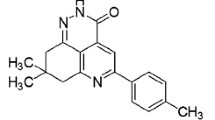Abstract
Formation of glutathione (GSH) conjugates with 2- or 6-(1-hydroxymethyl)- and 2-(1-hydroxyethyl)-DMNQ derivatives (DMNQ, 5,8-dimethoxy-1,4-naphthoquone) was carried out in phosphate buffer (pH 7.4), in the presence of glutathione-S-transferase (GST), in rat liver S-9 fraction and by perfusion, and the rates of conjugates formation were compared and correlated to cytotoxicity. The GSH conjugates of 6-(1-hydroxyalkyl)-DMNQ derivatives were formed faster than 2-(1-hydroxyalkyl)-DMNQ derivatives under all of the media, implying that steric hindrance was the cause of lowering the rate of conjugate formation of 2-substituted derivatives. For both isomers, addition of GST did not improve the reaction rate, compared with that in buffer, while the reaction in the S-9 fraction and the perfusate was accelerated to a great extent. The catalytic effect of the S-9 fraction and the perfusion on 2-isomers was greater than on 6-substituted ones, suggesting that S-9 fraction and the perfusate contain an effective system relaxing the steric hindrance of 2-(1-hydroxyalkyl)-DMNQ derivtives. Furthermore, a good correlation between the formation of the GSH conjugates and the cytotoxic activity of both naphthazarin isomers suggests that the steric hindrance is a cause of lowering the cytotoxicity of 2-isomers.
Similar content being viewed by others
References
Ahn, B. Z. and Sok, D. E. Michael Acceptors as a Tool for Anticancer Drug Design,Current Pharmaceutical Design, 2, 247–262 (1996).
Baik K. U., Song G. Y., Kim Y., Sok D. E., Ahn B. Z.: 2-Substituted Naphthazarins: Synthesis and Antitumor Activity.Arch. Pharm. Med. Chem. 330, 377–382 (1997).
Belisario, M. A., Pecce, R., Maturo, M., De Rosa, S. Arylation of sulfhydryl groups in vitro by the naturally occuring sesquiterpenoid benzoquinone ava-rone.Toxicology, 86, 89–108 (1994).
Finley, K. T. The additional and substitution che-mistry of quinones. InThe Chemistry of the Quinonid Compounds (S. Patai, Ed.), Part 2, pp. 878–1144. Wiley, London (1974).
Gant, T. W., and Cohen, G. M. Reaction of glutathione or amino acids with quinones forming semiquinone radicals, InFree Radicals, Oxidants Stress and Drug Action (C. Rice-Evans, Ed.), pp. 377399 (1987).
Gant, T. W., Rao, D. N. R., Mason, R. P. and Cohen, G. M. Redox cycling and sulphydryl arylation; Their relative importance in the mechanism of quinone cytotoxicity to isolated hepatocytes,Chem. Biol. Interactions, 65, 157–173, (1988).
Miller, M. G., Rodgers, A., and Cohen, G. M. Mechanisms of toxicity of naphthoquinones to isolated hepatocytes,Biochem. Pharmacol., 35, 1177–1184 (1986).
Monks, T. J., Anders, M. W., Dekant, W., Stevens, J. L., Lau, S. S., and van Bladeren, P. J. Glutathione Conjugate Mediated Toxicology.Toxicol. Appl. Pharmacol. 106, 1–19 (1990).
Song, G. Y., Zheng, X. G., Kim, Y., You, Y. J., Sok D.E., and Ahn, B. Z. Naphthazarin Derivatives (II): For-mation of Glutathione Conjugate, Inhibition of DNA topo-isomerase-I and Cytotoxicity.Bioorg. Med. Chem. Lett., 9, 2407–2412 (1999).
Thor, H., Smith, M. T., Bellomo, G., Jewell, S. A., and Orrenius, S. The metabolism of menadione (2-methyl-1,4-naphthoquinone) by isolated hepatocytes,J. Biol. Chem., 257, 12419–12425 (1982).
You, Y. J., Zheng, X. G., Kim Y. and Ahn B. Z. Naphthazarin derivatives; Naphthazarin Derivatives: Cytotoxic Mechanism and Evaluation of Antitumor Activity.Arch, Pharm. Res., 21(5), 595–598 (1988).
Zheng, X. G., Ahn, B. Z. (1999). Glutathione conjugates of some 2- or 6-subsituted 5,8-dimethoxy-1,4-naphthoquinone derivatives: synthesis and structure.Arch, Pharm. Res. 22, 384–390 (1999).
Author information
Authors and Affiliations
Corresponding author
Rights and permissions
About this article
Cite this article
Zheng, XG., Kang, JS., Kim, HM. et al. Naphthazarin derivatives (V): Formation of glutathione conjugate and cytotoxic activity of 2-or 6-substituted 5,8-dimethoxy-1,4-napthoquinones in the presence of glutathione-S-transferase, in rat liver S-9 fraction and mouse liver perfusate. Arch Pharm Res 23, 22–25 (2000). https://doi.org/10.1007/BF02976460
Received:
Issue Date:
DOI: https://doi.org/10.1007/BF02976460



